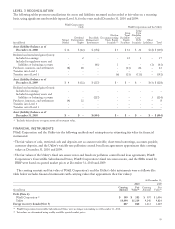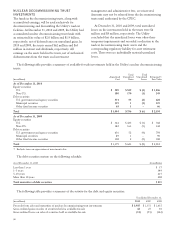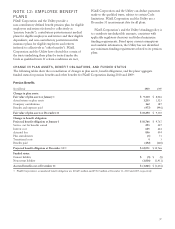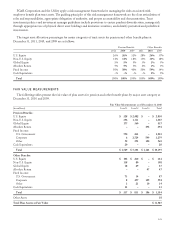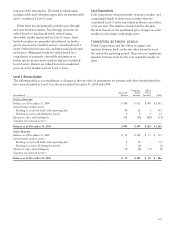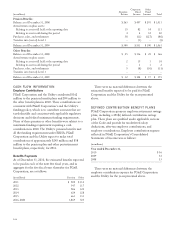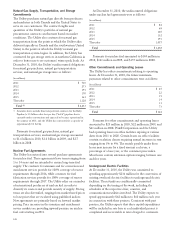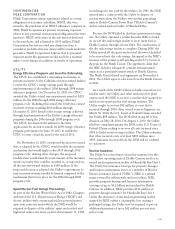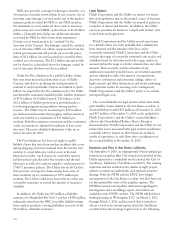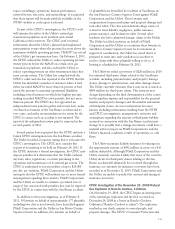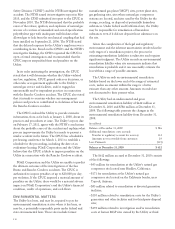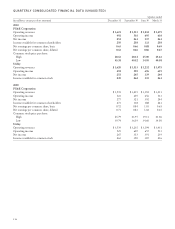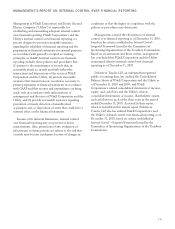PG&E 2010 Annual Report Download - page 109
Download and view the complete annual report
Please find page 109 of the 2010 PG&E annual report below. You can navigate through the pages in the report by either clicking on the pages listed below, or by using the keyword search tool below to find specific information within the annual report.
NOTE 13: RESOLUTION OF
REMAINING CHAPTER 11
DISPUTED CLAIMS
Various electricity suppliers filed claims in the Utility’s
proceeding under Chapter 11 seeking payment for energy
supplied to the Utility’s customers through the wholesale
electricity markets operated by the CAISO and the
California Power Exchange (“PX”) between May 2000 and
June 2001. These claims, which the Utility disputes, are
being addressed in various FERC and judicial proceedings
in which the State of California, the Utility, and other
electricity purchasers are seeking refunds from electricity
suppliers, including municipal and governmental entities,
for overcharges incurred in the CAISO and the PX
wholesale electricity markets between May 2000 and June
2001. At December 31, 2010 and December 31, 2009, the
Utility held $512 million and $515 million in escrow,
respectively, including interest earned, for payment of the
remaining net disputed claims. These amounts are included
within restricted cash on the Consolidated Balance Sheets.
While the FERC and judicial proceedings have been
pending, the Utility entered into a number of settlements
with various electricity suppliers to resolve some of these
disputed claims and to resolve the Utility’s refund claims
against these electricity suppliers. These settlement
agreements provide that the amounts payable by the parties
are, in some instances, subject to adjustment based on the
outcome of the various refund offset and interest issues
being considered by the FERC. The proceeds from these
settlements, after deductions for contingencies based on
the outcome of the various refund offset and interest issues
being considered by the FERC, will continue to be
refunded to customers in rates. Additional settlement
discussions with other electricity suppliers are ongoing.
Any net refunds, claim offsets, or other credits that the
Utility receives from energy suppliers through resolution of
the remaining disputed claims, either through settlement or
the conclusion of the various FERC and judicial
proceedings, will also be refunded to customers.
The following table presents the changes in the
remaining net disputed claims liability and interest accrued
from December 31, 2009 to December 31, 2010:
(in millions)
Balance at December 31, 2009 $ 946
Interest accrued 30
Less: supplier settlements (42)
Balance at December 31, 2010 $ 934
At December 31, 2010, the Utility’s net disputed claims
liability was $934 million, consisting of $745 million of
remaining disputed claims (classified on the Consolidated
Balance Sheets within accounts payable – disputed claims
and customer refunds) and interest accrued at the FERC-
ordered rate of $683 million (classified on the
Consolidated Balance Sheets within interest payable),
partially offset by accounts receivable from the CAISO and
the PX of $494 million (classified on the Consolidated
Balance Sheets within accounts receivable – other).
Interest accrues on the net liability for disputed claims at
the FERC-ordered rate, which is higher than the rate
earned by the Utility on the escrow balance. Although the
Utility has been collecting the difference between the
accrued interest and the earned interest from customers,
this amount is not held in escrow. If the amount of interest
accrued at the FERC-ordered rate is greater than the
amount of interest ultimately determined to be owed with
respect to disputed claims, the Utility would refund to
customers any excess net interest collected from customers.
The amount of any interest that the Utility may be
required to pay will depend on the final amounts to be
paid by the Utility with respect to the disputed claims and
when such interest is paid.
PG&E Corporation and the Utility are unable to predict
when the FERC or judicial proceedings that are still pending
will be resolved, and the amount of any potential refunds that
the Utility may receive or the amount of disputed claims,
including interest that the Utility will be required to pay.
NOTE 14: RELATED PARTY
AGREEMENTS AND
TRANSACTIONS
The Utility and other subsidiaries provide and receive
various services to and from their parent, PG&E
Corporation, and among themselves. The Utility and PG&E
Corporation exchange administrative and professional
services in support of operations. Services provided directly
to PG&E Corporation by the Utility are priced at the higher
of fully loaded cost (i.e., direct cost of good or service and
allocation of overhead costs) or fair market value, depending
on the nature of the services. Services provided directly to
the Utility by PG&E Corporation are generally priced at the
lower of fully loaded cost or fair market value, depending on
the nature and value of the services. PG&E Corporation also
allocates various corporate administrative and general costs
to the Utility and other subsidiaries using agreed-upon
allocation factors, including the number of employees,
operating and maintenance expenses, total assets, and other
cost allocation methodologies. Management believes that
the methods used to allocate expenses are reasonable and
meet the reporting and accounting requirements of its
regulatory agencies.
105


